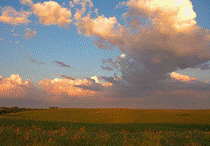
Proceedings of the North American Prairie Conferences
Date of this Version
2004
Document Type
Article
Abstract
In 1981, 20% of a 3.3-acre (1.3-ha) portion of an eroded Hochheim loam on the Retzer "Vista" hilltop, in southeastern Wisconsin, was planted in 12-ft (3.7-m) wide "source strips" so that intervening 48-ft (15-m) wide "invasion strips" resulted. A dry-mesic prairie seed mix was used in the two highest elevation source strips and a mesic prairie seed mix was used in three source strips on the lower, side-sloped portion of the hilltop. While the fanning-era loss of essentially all of the original topsoil made the site "drier," the associated bringing up of more and more of the subsoil, with time, also made the topsoil seedbed much more clayey. No seed or transplants were ever planted in the invasion strips. An alternating pattern of simulated burning/real burning/simulated burning, etc. was the only treatment done in the six invasion strips. In ten years, early stage forbs had invaded so well that they were found in every square meter of both types of invasion strip treatment. However, most late-stage forbs and all warm-season grasses invaded less than half of the invasion strips after 18 years. After 23 years, the results of belt transect surveys indicate that warm-season prairie grasses would now be found in 70% of the total invasion strip space.


Comments
Published in Dave Egan & John A. Harrington, editors, Proceedings of the 19th North American Prairie Conference: The Conservation Legacy Lives On..., University of Wisconsin-Madison, August 8-12, 2004 (Proceedings of the North American Prairie Conference, 19), Madison, WI: University of Wisconsin-Madison, 2004.